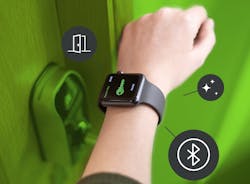Paxton10 Combines Access Control, Video Surveillance
Paxton Access sees a future of integrated electronic access control (EAC) and surveillance video, and to bring that future closer to the present, it has brought its Paxton10 platform to the United States.
In a product-launch webinar, Paxton unveiled the system, which was released in Europe in 2019 and will be available through distributors beginning Feb. 1. Erin Fujioka, Western regional manager for Paxton, says the product was the result of two customer demands. The first was a natural convergence of EAC and video. She notes that in a survey of 1,406 users of Paxton’s Net2 access control system, 936 had video surveillance in the same area. However, only 62 had the two systems integrated, which spoke to a second customer demand.
“The reason was the complexity in stitching the two systems together,” Fujioka says of the low number. “It’s a hassle. We realized we didn’t make it simple enough and needed to do something about it.”
The result is the Paxton10 platform, which requires the use of the Paxton10 server that’s connected to the internet through the local area network. From either a computer or through a mobile app, customers can manage access control, lock doors and view video — live or recorded — through the same system on-site or remotely. They also can do so for multiple sites through Paxton’s encrypted cloud technology.
Paxton10 can include and manage up to 1,000 doors and 1,000 cameras on a single system by adding Paxton10 door controllers, readers (HID card or fob, Bluetooth mobile or keypad) and cameras. Paxton provides several camera options, including dome or bullet models, but Paxton10 also can incorporate third-party IP cameras into the system by connecting up to four cameras to a single Paxton10 video controller.
Paxton10 can integrate with Paxton’s Entry video intercom system and its PaxLock smart locks, in addition to fire and intruder alarms, but it won’t integrate with Paxton’s own Net2 EAC platform. John Coursey, Paxton field training engineer, explains that Paxton10 and Net2 are meant to be entirely separate systems aimed at satisfying different customers, so there is no so-called backward compatibility between the two. A customer who wants to switch to Paxton10 from Net2 can use Net2 power supplies with new Paxton10 door controllers and can import users from the Net2 system into Paxton10, but it otherwise requires new equipment and a rebuild of the EAC system.
Aside from integration, Paxton10 also has simplicity in mind, Fujioka says. The server is plug and play, with options for PCB (printed circuit board) or Power over Ethernet (PoE) connectivity in addition to low-voltage hardwiring. Door controllers also have the option of wired or PoE connected models.
As far as “discovery” and “commissioning,” the system couldn’t be easier, Fujioka adds, using the setup of a Paxton10 camera as an example. “You take it out of the box and plug it in. That camera will automatically be discovered” by the server through the network. “You give [the camera] a name, press ‘Done,’ and it’s configured. It cannot be simpler.”
During the webinar, Fujioka also demonstrated the simplicity of managing the system and viewing video through either the computer interface or app, scrubbing through recorded video with a simple swipe on a phone. Customers can create customizable reports, replay video from only certain areas and combine access events with video footage. Future software updates are all free.
Despite the apparent simplicity, Paxton will hold free training sessions for security pros at its corporate offices and through distributors.
For more information, visit www.paxton-access.com.
About the Author
Will Christensen
Will Christensen is Senior Editor of Locksmith Ledger International magazine (www.locksmithledger.com), a sister publication and website to SecurityInfoWatch.com and Security Business.
